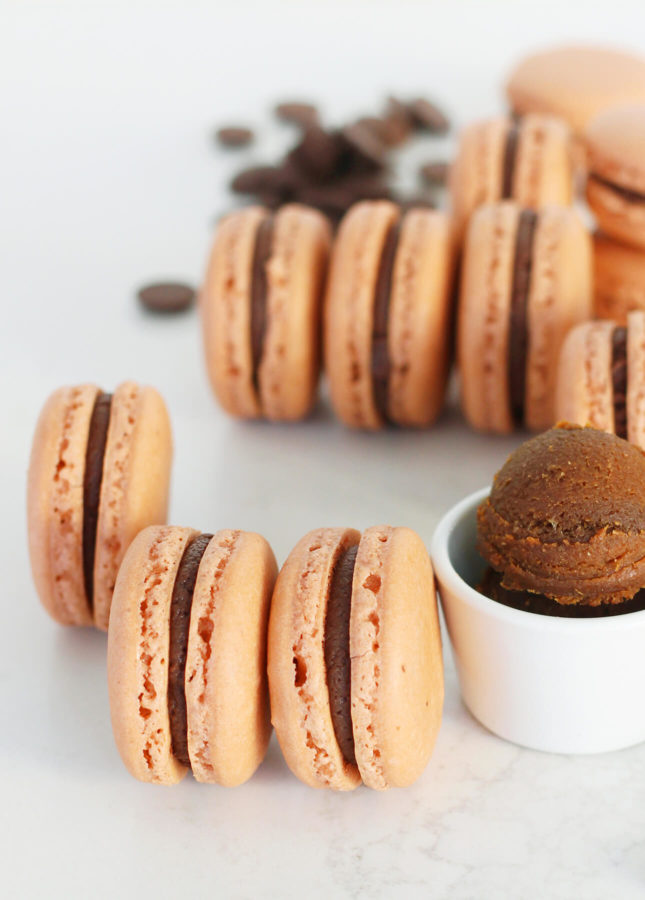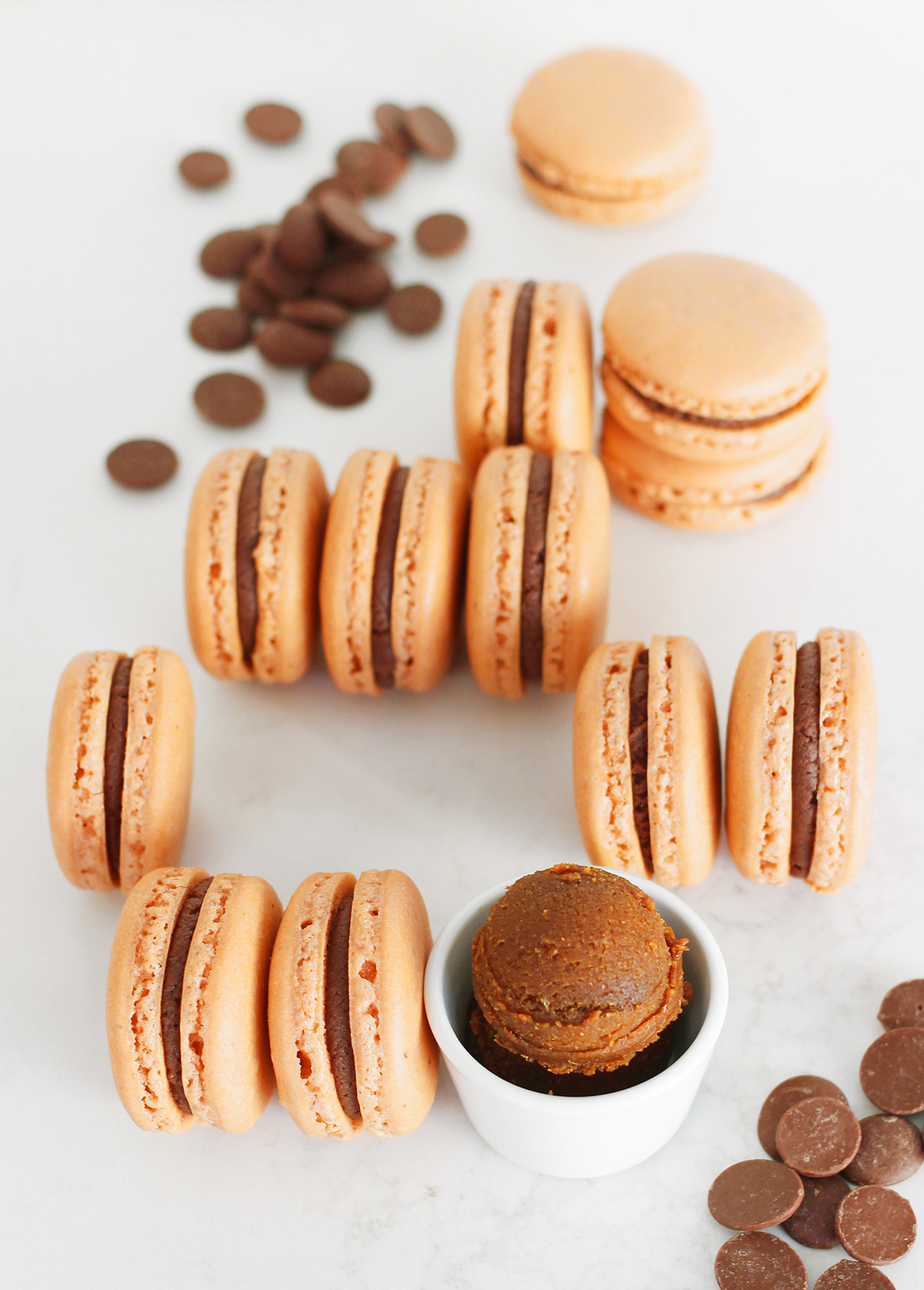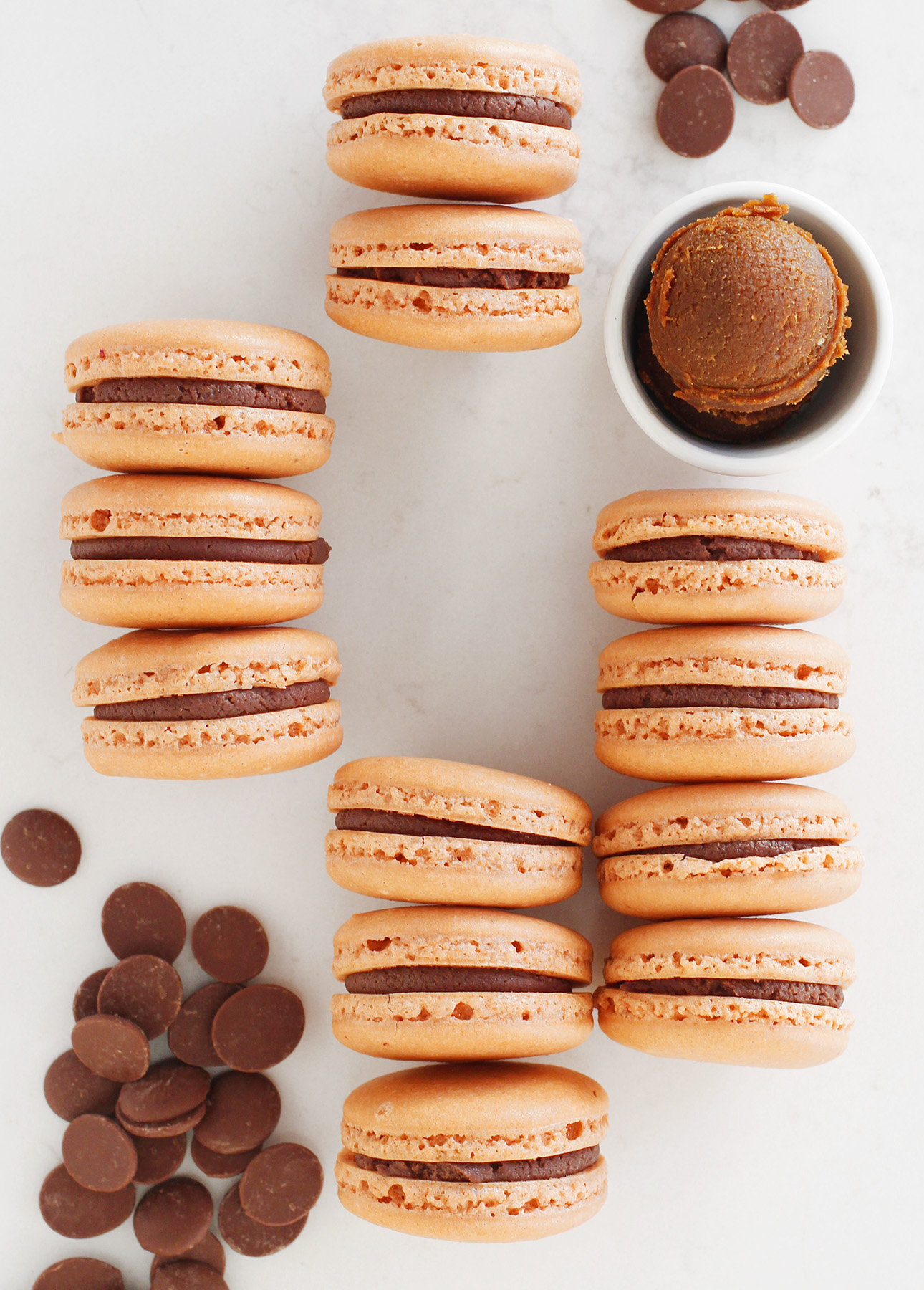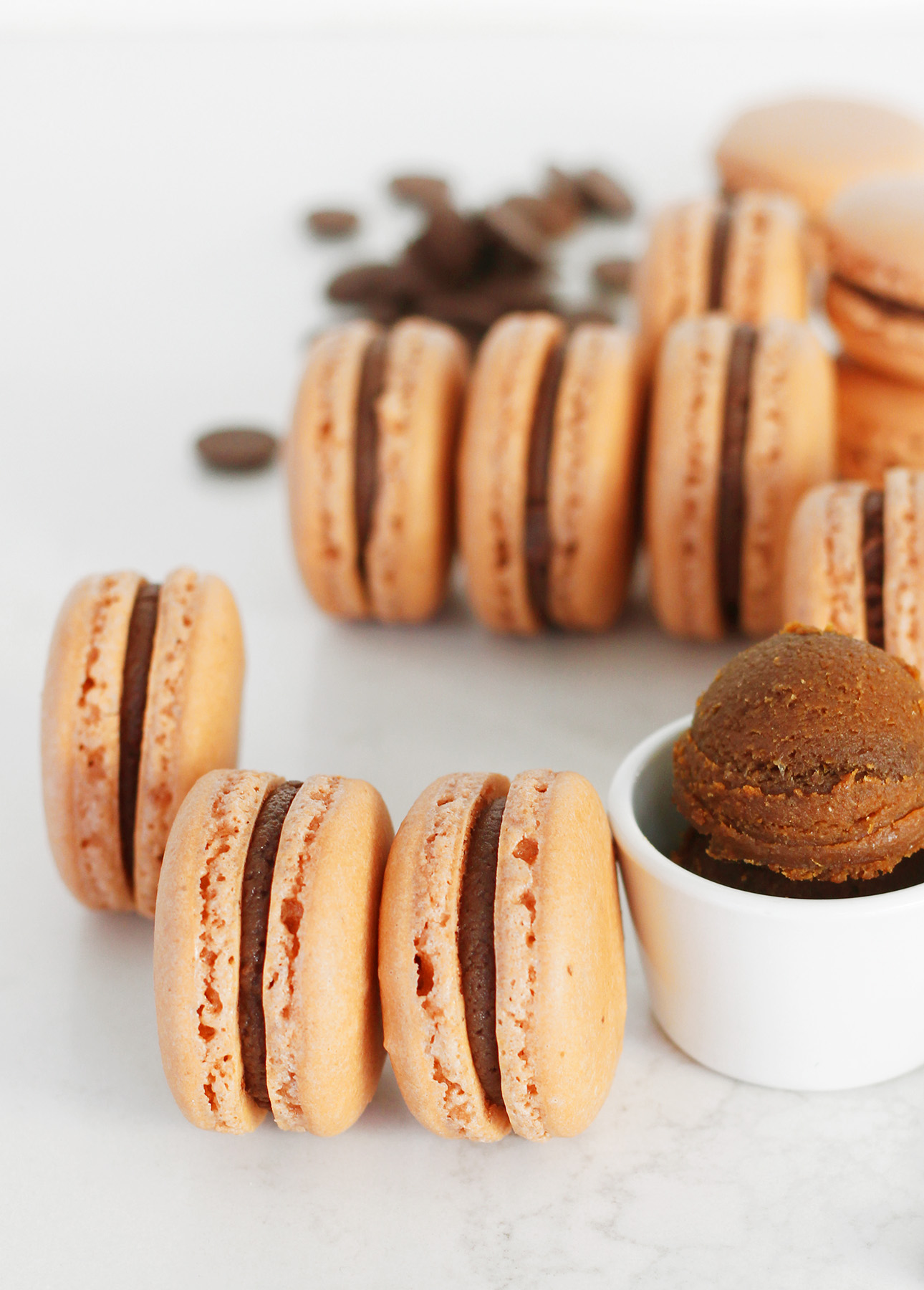- V
- GF
- NS
- DF
- View Recipe Key
Milk Chocolate Miso French Macarons
Milk Chocolate Miso French Macarons
These Chocolate Miso French Macarons combine the rich sweetness of milk chocolate with the savory saltiness of miso to produce a perfectly balanced, addictive treat. This recipe includes a variety of resources to help you make macarons, including a full French Macaron video masterclass!
This post contains affiliate links. Full disclosure is at the bottom of the article.
Desserts we make at home rarely include salty ingredients in any significant quantity, but pastry chefs love to incorporate savory elements in their desserts. The balance between savory and sweet is what makes the flavor of professional pastry creations so complex and memorable.
Personally, I like a classic brownie or chocolate chip cookie, but some of my favorite desserts—the ones I make regularly—are those that taste less sweet than a homestyle dessert would. There are many ways to balance out the sweetness in desserts: one of my favorite ways is to use citrus fruits. The sharp, zesty flavor of lemons and limes cuts through rich textures, balancing out the sweetness in desserts such as cupcakes and pies. Oranges and clementines add an incredible aroma to desserts and can completely change the flavor profile of familiar treats such cookies and carrot cake for the better.
A more unusual ingredient you can use to add depth and complexity to dessert is a classic Japanese savory seasoning: miso paste. Though it may sound strange to use an ingredient you’d usually add to soup in a sweet dish, the rich, nutty, salty flavor of miso is often just what you didn’t know you needed to transform your desserts from great to extraordinary.
Miso has long been used by pastry chefs, whether they stick to a more traditional pastry philosophy or like to create resolutely modern desserts. The first time I tasted a miso-infused macaron was at Pierre Hermé, in Paris. Pierre Hermé is my macaron mentor: his creations are what triggered my lifelong obsession with the French treat, and the flavors he uses in macarons I always find inspiring. Pierre Hermé’s miso macaron combined the fermented soy paste with lemon. It was a truly lovely combination: the soft, round richness of white miso softened the lemon’s sharp acidity. This convinced me that miso truly was an ingredient I needed to learn to use in my own desserts, too.
Wondering what a miso-infused dessert tastes like? Miso does not give a funky flavor to desserts, nor does it make them too salty. Think of miso as an enhancer: it adds depth and richness to flavors, and a touch of saltiness that enhances sweet ingredients.
There are different varieties of miso, and the flavor varies widely depending on the fermenting time. As a general rule, the darker the miso, the longer it has fermented and the more pungent the flavor. Red miso (aka miso) goes especially well with bold ingredients, such as chocolate, caramel, and banana. White miso (shiro miso) is fermented for only a few months, which means it has a delicate flavor and is less salty than other miso varieties. If you’ve never used miso in desserts, white miso should be your starting point: it is suited to most desserts, from ice cream to apple pie.
In my Milk Chocolate Miso French Macarons, I use red miso because it is married to milk chocolate, which has a lively, very sweet flavor. The sharp taste of red miso reins in the sweetness of miso chocolate and provides incredible depth as well as an addictive je ne sais quoi to the flavor of the macarons. That “je ne sais quoi” would be umami, which literally means “pleasant savory taste” in Japanese.
If this all sounds confusing, just make the milk chocolate miso ganache and taste a spoonful of it. Once you taste the combination of chocolate and miso, there’s no turning back. You can use this ganache to fill macarons, of course, but you can also slather it in a layer cake or over brownies. You just can’t go wrong!
FIRST TIME MAKING FRENCH MACARONS?
If this is your first time making macarons, prep, read, and watch before you start: Macarons are finicky to make, but if you set aside enough time so that you won’t be rushed, you can do it. I have a variety of resources available for you:
- A detailed step-by-step tutorial with photos to guide you through the process;
- A thorough troubleshooting guide that’ll help you understand mishaps, should they happen;
- And a 30-minute French Macaron Video Masterclass—which I highly recommend watching before you make macarons for the first time. There’s nothing like watching someone making macarons to learn how to make them properly—that’s how I learned over 10 years ago, and that’s how thousands of my students did too!
NEW: French Macaron Video Masterclass
Learn how to make perfect French macarons at home with my detailed video masterclass, now available to everyone for FREE and unlimited watching! This masterclass was previously hosted behind a paywall on an educational site where THOUSANDS of students rated it 5 STARS! It’s now available to all macaron lovers worldwide, for absolutely free ❤️
My detailed French Macaron Video Masterclass is divided into 14 handy lessons that will make you a macaron expert in no time. I designed my masterclass both for novice bakers who want to learn new skills, and for experienced bakers who are seeking to master a new and impressive dessert. Let me guide you through the essential equipment you need, the important steps to follow, the techniques to master, and the potential pitfalls to avoid. You can watch the videos on your own time, start practicing, share with other budding macaron makers, and ask me questions if you encounter difficulties along the way.
I’m confident that this video class will enable you to create perfect French macarons. Watch the class now!
If you enjoy my French Macaron Masterclass, make sure to “like” it on YouTube to allow other macaron lovers to discover it. Thank you and happy baking!

Milk Chocolate Miso French Macarons
Ingredients
For the milk chocolate miso ganache filling
- 170 g best quality milk chocolate (Valrhona, Ghirardelli, and Lindt are all quality brands)
- 42 g unsalted butter
- 45 ml heavy cream
- 15 g red miso paste (also called aka miso paste)
For the macaron shells
- 3 large egg whites, separated two days in advance, stored in an open container in the fridge (about 3.5 oz/100 g)
- 210 g powdered sugar
- 125 g almond flour
- 30 g granulated sugar
- 1 drop beige or brown gel food coloring (optional)
Instructions
- For the milk chocolate miso ganache filling: In a double boiler or in the microwave (at the lowest heat setting), melt the milk chocolate, butter, cream, and miso together. Whisk to thoroughly combine. Strain into a bowl or a container. Let cool until the bowl is no longer hot to the touch. Cover and refrigerate for 12 to 24 hours before filling the macarons. Return to room temperature at least an hour before using. (Can be refrigerated for up to 1 week.)
- For the macaron shells: **Return the egg whites to room temperature at least an hour before making the macarons shells.**
- In the bowl of a food processor, add the almond flour and powdered sugar, then process until the mixture is thoroughly incorporated, 30 seconds to a minute. Sift the mixture to make sure no lumps or bigger bits of almonds are left.
- In the bowl of a stand mixer fitted with the whisk attachment, or in a large bowl if using a hand mixer, whisk the egg whites with the cream of tartar or lemon juice on medium-high speed until frothy, about 1 minute, then slowly pour in the granulated sugar. After 2 minutes, add the gel food coloring, if using. Keep beating until the egg whites are stiff, dense and creamy, about 3 minutes more.
- Add the almond and powdered sugar mixture to the egg whites and, using a spatula, gently fold in the dry ingredients: slide your spatula all the way to the bottom of the bowl and come back up to the top. Do this about 6 times to incorporate the dry ingredients, then keep folding for a total of about 14 strokes until no pockets of dry ingredients remain and the mixture drops from the side of the spatula in a slow, lazy ribbon. Start testing the ribbon stage early to avoid overfolding.
- Stack two baking sheets and line the top sheet with parchment paper. If you're not using parchment paper sheets, cut out the parchment paper so it fits exactly over the bottom of the sheet to make sure the macarons will lay flat. Slide macaron templates under the parchment paper, if using.
- Transfer the macaron batter to a pastry bag fitted with a ½-inch (1.25-cm) round tip. Pipe 1 ½-inch (3.8-cm) rounds of batter, evenly spaced but still close to one another as they will not expand much.
- Carefully slide the macaron templates off the baking sheets, if you used them. Let the shells rest on the baking sheets for 20 to 30 minutes.
- Preheat the oven to 275°F (135°C) with a rack set to the middle position. Bake each sheet of macaron shells for 13 to 16 minutes, or until the shells are firm on their feet when you lightly tap on them with the tip of a finger.
- Let the shells cool completely to room temperature before assembling them, about an hour.
- To assemble the Milk Chocolate Miso French Macarons: Pair same sized shells together and set side by side on a work surface. If you refrigerated the ganache, let it warm back up to room temperature for at least 30 minutes, or until spreadable. Using a small offset spatula, spread some chocolate ganache over half of the shells. You can also transfer the milk chocolate ganache to a pastry bag fitted with a round tip to pipe the ganache over half of the shells. Close the macarons, very gently pressing the second shell over the filling.
- STORAGE: Store the assembled Milk Chocolate Miso French Macarons in an airtight container and refrigerate overnight before indulging.French macarons will keep, refrigerated, for up to 3 days. You can also freeze assembled macarons in an airtight container for up to 1 month.
- SERVING: Always bring these Milk Chocolate Miso French Macarons back to room temperature before serving.
Did you make this?
Tell me how you liked it! Leave a comment or take a picture and tag it with @foodnouveau on Instagram.
This site is a participant in the Amazon Associates Program, an affiliate advertising program designed to provide a means for the site to earn fees by linking to Amazon and affiliated sites.
If you click on an affiliate link, I may earn advertising or referral fees if you make a purchase through such links, at no extra cost to you. This helps me create new content for the blog–so thank you! Learn more about advertising on this site by reading my Disclosure Policy.
Author: Marie Asselin





WHAT DID YOU THINK OF THIS RECIPE?
Rate + Review